Canadian <Metadata> Forum
Government of Canada
Metadata Framework
Nancy Brodie
Information Management
Chief Information Officer Branch
Treasury Board of Canada, Secretariat
| © Treasury Board of Canada, Secretariat. Reproduced with the permission of Nancy Brodie. |
Available also in [PDF 482 KB]
Frameworks in the Government of Canada
A framework translates a vision into a set of management expectations
A framework brings together and connects diverse initiatives
A framework integrates guidance and standards
A framework simplifies complexities
Evolution of GoC Metadata Framework
- 1970s
- Library cataloguing - MARC Format
- 1980s
- Rules for Archival Description (RAD)
- 1990s
- FGDC CSDGM (Content Standard for Digital Geospatial Metadata)
- Government Information Locator Service (GILS)
Diverse needs, many data elements, little commonality
Complexities Standards only understood and used by specialist communities
Little capacity for interoperability
Extremely labour intensive to apply
A situation begging for simplification
Hence a Framework
GoC Metadata Framework
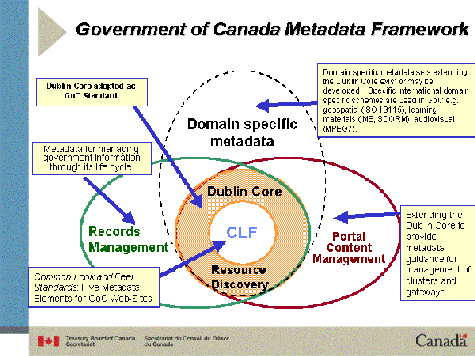
Environment Canada's Metadata Framework
Three Levels of Metadata
A flexible strategy that matches effort to need using internationally recognized standards.
-
Discovery
-
Most EC information assets will be discovered at this simplest level. This could be for a collection, database or single object.
-
Access
-
Using the full geospatial and/or biological profile this level will provide for the comprehensive description and disclosure of data.
-
Exchange
-
This level will allow for the use of biological or geospatial metadata at the station level for visualization and data extraction web services.
Hierarchical Application of Metadata Standards at Environment Canada

Dublin Core: Metadata Standard for Resource Discovery
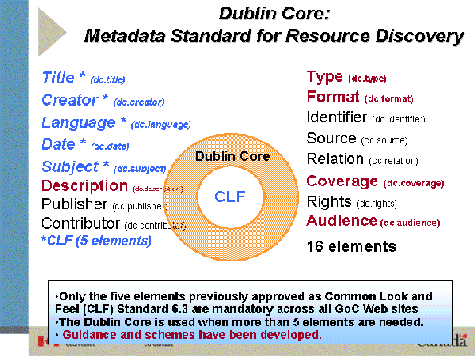
-
Only the five elements previously approved as Common Look and Feel (CLF) Standard 6.3 are mandatory across all GoC Web sites
-
The Dublin Core is used when more than 5 elements are needed.
-
Guidance and schemes have been developed.
Information Assets Management Framework from
Health Canada - extract
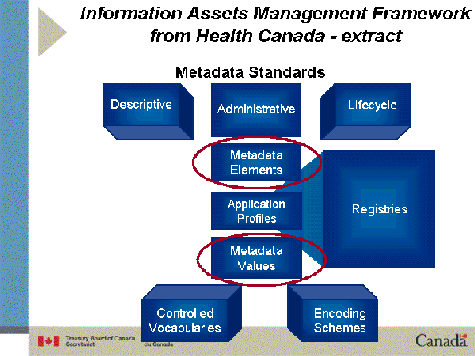
Semantic model
Metadata Elements
-
Dublin Core defines the semantics (meaning) of the 16 elements
Metadata Values
- A controlled element : the content or value is
- formatted in a standard way (encoding scheme), or
- a term from a specified list of acceptable values or controlled vocabulary
-
Controlled vocabularies should be named, registered and identified in metadata records as schemes
-
An element can have multiple schemes
Common semantics are key to interoperability
Dublin Core schemes for interoperability
- Dublin Core Metadata Element Set
- Dublin Core Qualifiers
- DC Element Encoding Schemes
- Rules and controlled vocabularies
- DCMI Type Vocabulary
- ISO 639-2: Codes for the representation of names of languages
- ISO 3166: Codes for the representation of names of countries
- Getty Thesaurus of Geographic Names
- Internet media type (MIME)
-
Subject Schemes
http://dublincore.org/usage/terms/dc/current-schemes/
Build on what is widely accepted and used
Schemes for interoperability within GoC
Accommodate diversity
-
Define usage of DC schemes
-
Broad, high-level GoC-wide schemes
-
More specific domain or departmental schemes
Issues
- Defining broad and high-level
- Managing scope of schemes
- Mandatory use of GoC scheme
Wide-spread use of common schemes is key to interoperability
Principles for registering GOC Schemes
-
Controlled vocabularies used by the Government of Canada should be registered and publicly available (TBITS 39.2)
-
The National Library of Canada (NLC) is the registrar of standardized vocabularies used in GoC
-
Vocabularies must be bilingual
-
Vocabularies must be created and maintained by trusted authorities which have a mandate within a department to develop and maintain the vocabulary
-
Departmental thesauri must be capable of being mapped to the GoC Core Subject Thesaurus
Evolving principles for developing GoC schemes
-
Applicable: terms represent content found on a significant number of Government of Canada Web sites, and/or are of substantial significance to Government of Canada programs/services
-
Recognizable: terms are understandable by implementers/indexers
-
Unique: no terms will be a synonym of an existing term [within one scheme]
-
Client-centric: concepts and terminology used in presentation layer should be tested with the public
Established GoC Schemes
Mandatory elements
- dc.creator
- Titles of Federal Organizations, GEDS
- dc.subject
- GoC Core Subject Thesaurus
Optional elements
- dc.coverage
- Canadian Geographic Names Data Base
- Regions of Canada
- dc.type
- Government of Canada Type Scheme
- dc.audience
- Government of Canada Audience Scheme
Where we are today...
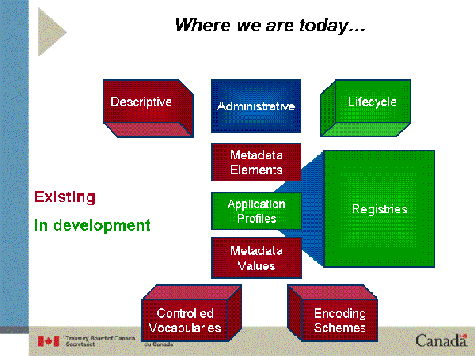
Facets to support access
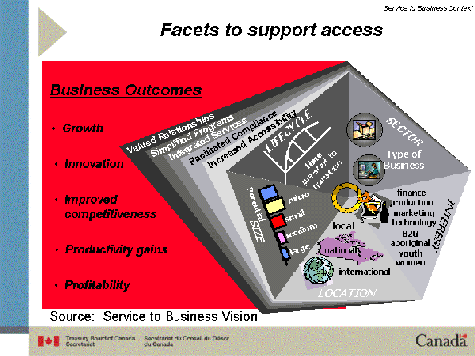
Metadata elements can be considered "facets" for organizing government Web sites
-
Audience
-
Geographic coverage
-
Date
-
Type
-
Subject
Business Outcomes
-
Growth
-
Innovation
-
Improved competitiveness
-
Productivity gains
-
Profitability
Source: Service to Business Vision
The Metadata Environment
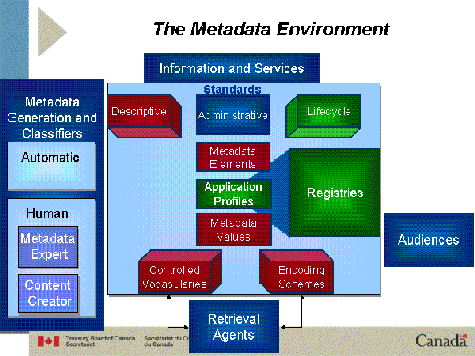
|






